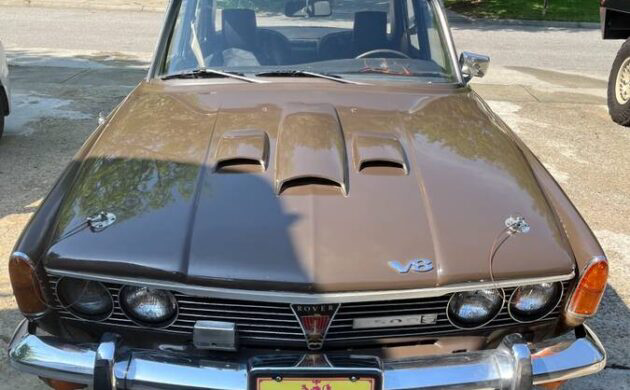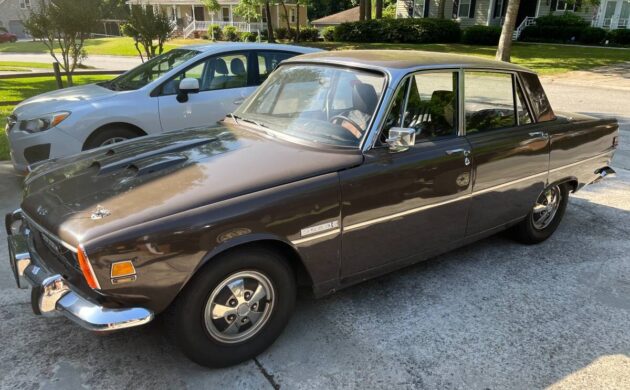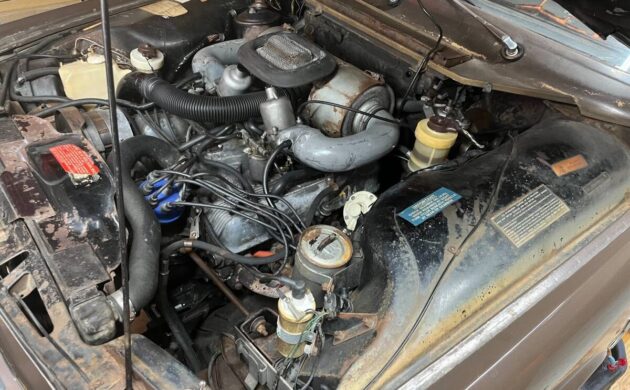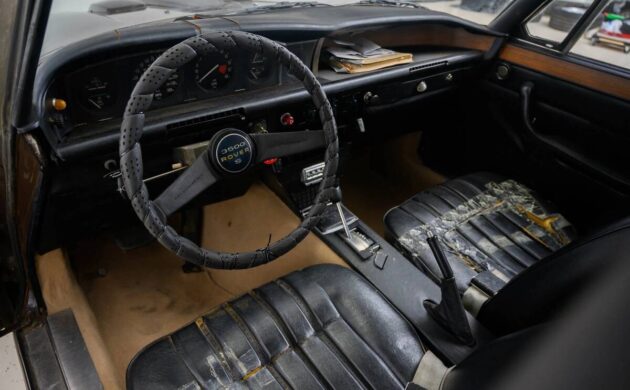When Rover purchased the rights to the all-alloy Buick 215ci V8, it had several vehicles targeted for its use. Slotting the motor under the hood of its P6 model created the 3500 S. This 1970 example is not perfect, but it is a solid driver with no pressing problems. Lifting its presentation to a higher level is possible, and the buyer will probably focus on its interior during that quest. The Rover is listed here on Craigslist in Hanahan, South Carolina. The seller set a price of $6,500 OBO for this classic, and I must thank Barn Finder Rocco B for spotting it.
This Rover makes a positive first impression, although I am willing to admit that its shade of Mexico Brown is far from my favorite. However, it shines nicely and has no significant flaws, meaning the new owner could leave it untouched. There is evidence in a couple of locations the car has received prior touch-ups, but that is acceptable with any vehicle of this vintage. The panels are straight, but this classic’s lack of rust is the best news. That could be an issue with these vehicles, but this one has avoided that fate. There is visible surface corrosion but nothing that appears ready to make the leap into panel penetration. The hood pins are a later addition that look entirely out of place, and one rear bumper over-rider is missing. Otherwise, the remaining trim and glass look acceptable for a survivor-grade car.
Lifting the Rover’s hood reveals the 3.5-liter all-alloy V8, which sends 184hp to the rear wheels via a three-speed automatic transmission. The journey down the ¼-mile should take 17.4 seconds, while power assistance for the steering and disc brakes means the driver won’t waste too much energy during any trip. Interestingly, Rover introduced a four-speed manual version of the 3500 in 1971, and while its engine produced around 20% less power, it slashed the ¼-mile ET to 16.3 seconds. The seller states they recently cleaned the carburetors, repaired the exhaust, and replaced the transmission filter. The Rover runs and drives well, making it a turnkey proposition for a new owner.
I initially said that a large slice of the work required to lift this Rover’s presentation would focus on its interior, and this photo supports that statement. The front seat upholstery is split and torn, the dash top has numerous cracks, and there is evidence of broken plastic in areas like the console. However, most of the timber trim looks okay, and there are no signs of rips or tears on the back seat. Locating secondhand items to replace those beyond repair could be challenging and will probably involve patient online searching. Some companies in the UK will sell and ship reproduction pieces to foreign buyers, but the new owner must consider their cost versus the potential return if any restoration work is to remain financially viable.
Although some enthusiasts may find the paint shade gracing the panels of this 1970 Rover 3500 S uninspiring, it is very much of its time. Considering the evidence of potential previous touch-up work, the new owner might elect to perform a color change as part of any refurbishment. However, it is worth keeping the potential value of this classic in mind when contemplating which path to follow. Although they are relatively rare, it is unusual for a 3500 S of this vintage to sell beyond $9,000. A brief internet search revealed this isn’t the first time this car has hit the market, with a successful auction in June 2020 netting $4,200 for that owner. If the current owner is willing to negotiate and be flexible, potential buyers could score this car much lower than the existing asking price. Is that enough for you to consider pursuing it further?












Nice,,,no VERY nice cars. I was going to say, lose the cheesy Kmart wheel covers, but those appear to be original. It’s always odd to me, to see SU carbs on top of a primarily US motor. They are probably better than the old Rochester the British would have nothing to with. The automatic shouldn’t scare anyone, I read, it was the tried and true BW unit, used on a SLEW of cars, including Rolls-Royce. Has the best of both worlds here, can’t go wrong, except for the inevitable dog jokes that may surface. Favorite British sedan, just because of what it is.
I agree, Howard, that it’s a very nice looking car. I’ve always wanted one and most of them are tin worm victims. I’m not so sure about the Borg-Warner tranny as a lot of Jaguar owners (I have 3, none with the B-W) complain about them. My 90 XJS convert. has the GM hydramatic that works like a dream. Not sure what’s in the 91 XJ40 saloon. It might be the B-W, which could explain why I can’t get it out of ‘limp-home’ mode.
Howard my friend, Rolls-Royce and Bentley didn’t use a Borg-Warner automatic transmission. They only used the original GM Hydramatic starting in 1953 and continuing thru 1967 [thru 1968 in the UK cars], then switching over to the Turbo-Hydramatic. The big Vanden Plas Princess limousines also used the R-R version of the Hydramatic. They were built under GM license to R-R specs, by Hersey in France.
Jaguar and Daimler did use the British built B/W, as did other smaller British car makers.
When Rolls-Royce began using the Hydramatic, in typical fashion the company insisted in higher quality levels of various machined surfaces, including the internal clutch drum surfaces. The original GM specs resulted in a rough surface, so R-R wanted the surfaces polished to a higher level. In theory that was a great idea, however they quickly realized the clutches kept slipping and didn’t last long, so they quicky went back to the original GM specfications!
Thirty five years ago my father and I took a Rover 2000 TC from Phoenix AZ back home to Ohio after visiting my brother. The trip of 3 days proved uneventful. The TC was a 4 cyl with a 4 speed that proved itself and was comfortable as long as you weren’t stuck in slow traffic. No AC but it did have the ice alert which, along with inboard rear disc brakes, de Dion tube suspension and the 4 speed made it a nice well handling sedan. I’d like to find another but they are few and far between.
I never owned one of these but I did own the next model, the SDX automatic. it was a really nice, luxurious car by British standards of the time, however, the 3.5 V8 was no great engine IMO. Smooth, economical and quiet but nothing to rave over in standard form, however, I believe it was used in a lot of race cars, hot rods and dragsters here in UK so it must have been a very strong engine as well.
There was once someone who owned a dejon mustard yellow rover like this in the clifton park area of ny state. I like them as not many survive around here and are not belly button classics like everyone has.
Those are original wheel covers
Drove one of these in the mid 80’s stole it for $1500 from a neighbor. I felt like James Bond in it. reliable, comfortable and very different. Nightmare of a braking system!!
Be still my wallet…
Nice example, it would appear to be a good offer. The rear seats are a work of art and have often been used to make custom sofas in the past.
The only thing, why did Rover just cut holes in the hood rather than address cooling issues on an ” executive” import to the US market. They did it again with the SD range.
Wonder why BMW took the sales….?
A former classmate had a Rover in the mid 70’s. It had imitation lambs wool seat covers and long white fur on the dashboard and headliner. He took it to use for his drivers license test. When the examiner got into the car, the first thing he asked him was “is this thing certified “.
How many hood scoops are enough?
I always saw ads for these things in my dad’s Road & Track magazines. But I’ve never seen one in the wild. They DO exist!
Down near Charleston, SC (5 hours away) or I’d want a personal look-see. Wouldn’t be surprised if $5000 cash would take it. Not an easy sell despite the rarity.
Curious about the way the 2 SUs are set up. There doesn’t seem to be a crossover to the manifold, so each carb services 4 cylinders. Would seem to be troublesome synching them. I’ve had to work on MGs, Triumphs, and Healeys with the 2 SUs (obviously different sizes) and a E-type with the trip-carb setup. Synching them is fun and a bit of an art with or without a gauge (I used a rubber hose and my ear mostly).
Also curious about the hood scoops – wouldn’t the engine drown in a downpour? My British cars have had a tendency to faint when a dark cloud passed overhead.
My Scottish cousin had a few of these. In the early 80s when we were around 18 , he came over to visit and we scoured the junkyards looking for a Skylark or Cutlass with a 215 as he wanted to put the 4 barrel intake and carb set up on his. We did find one, but boy did he get some problems trying to take it home ! Going through the X rays the security people must have thought it was a bomb as there was all sorts of TSA people who took him aside and pulled the suitcase out and did a thorough search of all their stuff. Needless to say , his parents weren’t very happy with him , but it all worked out in the end.
Don,
In the early 1990s I was at the big Beaulieu AutoJumble [old car flea market] in England. One of the things I was looking for was a set of ignition coils for my 1932 Rolls-Royce. I was lucky and found a NOS, unused set of the correct Royce electrical coils. They were quite expensive, and I didn’t want to mail them back to America, so I decided to being them back with me when I flew home.
The coils were carefully wrapped and safely ensconced in my briefcase. On arrival at Heathrow Airport, I waited in line to go thru security. As my briefcase went thru the scanner, I noticed the conveyor belt reverse direction over & over again. I had no idea it was my briefcase that an increasing number of security people were looking at.
After a few more minutes I was asked to follow a couple of security guys and we went into a small room, where I noticed my briefcase sitting on a desk in the center of the room. I was offered a chair and sat down. One of the security guys said he wanted to ask me some questions, and I said sure, go ahead.
After a few general questions [What was the reason for your trip, etc.] He asked me what was in the briefcase. I started to give him a list of various paperwork and I rattled off a mental list of the old car brochures I had bought. He stopped me and said he didn’t care about paperwork, what else did I have in there? Any . . . Metal items?
It was then that I realized what I had done. Not only did I have the twin coils in there, firmly attached to their alloy base including their original wiring, I also had a small rectangular and rather expensive 8 day clock, that I hoped would fit in a matching hole in the division panel of my 1948 Rolls-Royce Silver Wraith limousine, as the original clock was long gone. I had included the clock in the same packaging as the coils.
What do 2 round cast iron posts, each surrounded with coils of tightly wound wiring, look like when next to a clockwork mechanism, especially when viewed thru an x-ray machine, by airport security guys? OOPS!
All of a sudden I realized what they thought they were looking at, and let them know the pieces were for my antique cars. I offered to open the case, but they refused to let me open it. It wasn’t until I remembered that my other carry-on luggage piece had all my assorted paperwork I would use in my Beaulieu search for the parts I wanted. Included in various papers were photocopies of the correct coils and the clock, and more things like the specification sizes of the coils.
They actually had the other bag just outside the door, and in a few minutes I was able to lay out everything on the table. After checking it all carefully, they agreed what they were being shown, matched what they saw in the X-ray image. So they allowed me to open the briefcase, and one of them carefully pulled out the package containing the coils and clock. On examining the parts, they were satisfied that what I had WAS NOT A BOMB!
The tense atmosphere in that room quickly dispersed, and everyone apologized [me too!] for causing the ruckus. All smiles now, I was told it was OK to head for the plane, except they would take me over to the gate in an electric cart because there was no way I could make it before the gate closed.
The security guard was also carrying the coils and clock in a special security bag that was given to the airplane crew, and I was advised to ask for it when I went thru US Customs. On going thru US Customs at Dulles Airport, I was admonished by the agent to “never do such a stupid thing again” [his exact words], and to show up early at security the next time I flew anywhere, because I was now on some sort of “low risk watch list.
That said, I never, ever, had any more problems going thru TSA security, either in the USA or Europe.
And the clock fit into the hole with just a slight amount of sanding to the opening edge.
Wow, I’m sure that looked more like a bomb than my cousins carb and intake , but they have to be on the alert for anything that looks different. He likely went through something similar . Glad it worked out for you too !
Wonderful museum at Beaulieu, and a beautiful place too. When I went it had lots of interesting stuff, in addition to Lord Montague’s estate and gardens. I took the train from London and then a cab through the New Forest and it’s wild horses roaming around to suddenly emerge at this place. BTW, the English pronounce it Beooo (as in view)lee. Guess they don’t like the French sound :-).
Just to correct a minor error, the slightly later, (and non USA), P6 3500 manual transmission cars, (also confusingly named 3500S), didn’t have less power, they had about 10% more, due to a better routed exhaust that doesn’t fit the autos. There is strong demand for these US models outside the USA and this one is likely to end up there.
seemed almost every yr the kid brought ina Rover P6 (’64/9) with more hood scoops. Guess I was the only kid ta notice so pointed it out to the other boys, “Hun?” they said. GearHead from early (but hid it from the other hippies at the tail end of those above yrs -or- get outcast). Not sure he made it to “3” but I’d sure like to have that motor today. Y & when did they stop production?
Aligned a Rover car don’t remember the model or year but do remember taking the dash pocket out to get to the right side camber caster adjustments, the left side required a lot of twisting, turning and the use of some French vocabulary wishing for a drop light that wouldn’t keep burning you turned the wrench about 12 degrees. Oh the good old days.
The three hood scoops are a mystery to me, cooling obviously, though the Australian spec’d cars lacked them. It’s not as if we don’t have hot days here.
Only reason I can come up with is that the USA spec’d cars ran hotter for emission control reasons.
earlier models had fewer
chrlsful,
The 3500s was the only version of the P-6 cars to have the hood scoops, and every one I’ve seen has 3 scoops. The original P-6 was the TC2000, and they didn’t get the hood scoops. That said, it’s easy to add them, so I’m sure a few people with a TC200 did so.
There is nothing in the repair manuals or literature indicating the reason for the hood scoops, but it’s widely understood they were added to help manage underhood temperatures due to the V8.
In the late 1970s and into the 1990s my shop became known in the mid-Atlantic area as a place to get these cars worked on, and over those years I owned several nice original examples.
Looking at the position of the scoops, I can only guess they may have been added to cool the carburetors in particular, perhaps to help prevent vapor lock or percolation-driven flooding or fires.
AFAIK US-market V8 models were the only ones to get all 3 scoops, but some later UK V8s got a single scoop, perhaps to use up leftover scoops after they abandoned the US market.
SubGothius,
I just got an email reply from a long-time friend in England who worked at a Rover mains dealer. He said that both sizes of the scoops were in the Rover spares list and more than a few were added by dealers to make the TC2000 look more sporty, but he never heard of the scoops being added for better cooling. He said the ones his employer added were painted flat black. He also said the scoops were one of the first things to sell off Rover 3500 cars in the junkyard.
So, if as Bill says his friend said that they weren’t for cooling, what pray tell were they for. The SUs certainly didn’t need ‘air induction’. And if they were just sporty adornments, they would seem to be an aerodynamic mistake on a car that looked to have fairly low drag.
Eric,
The scoops WERE needed to cool the V8 3500 P-6 Rovers, but not the 4-cylinder TC2000 cars. Until recent years, a hot day in London was 80f, less outside the cities, simply not hot enough to require scoops unless there were other underlying cooling issues like a clogged radiator. I’ve spent many a “hot” August day in England, and I can’t imagine needing scoops to cool the engine compartment of a TC2000 in the UK.
But the scoops DO appear to make a Rover TC2000 run faster!
My uncle had a Rover in Rockville MD when I was a kid.
My best memory was the flock lined tool drawer in the dash. Each tool had a proper sized cutout.
I think it was a late 60’s model, a bit earlier than this one.
Just goes to show, the Brits would put SUs on anything! Personally, I liked them, and hated when so many converted to ZSs with the rubber diaphragm. No doubt can thank the EPA for that.
Mark,
Right on! ‘ Love SUs. Sheer genius in that design! BTW, the positioning of the carbs on this 215 V8 is exactly as it was in the handful of factory-built MGBGTV8s.
FWIW,
Allen
8 Mikuni / Keihins in the valley?
Bill,
Know Y they stopped making that motor? Was the last Brit a bigger & more suv like box (by same co, rover)?
chrlsful,
The Rover V8 in 4.6 L was used in Land Rover Discovery models up thru 2004, for north America only. Rover continued to build engines on a limited basis for TVR until {I think} 2011
A company named Coscast in the Birmingham area is said to make hi performance versions up o 5.0 L,
The reason they stopped production was the engine was based on 1960s engineering, and while an excellent idea for Rover to purchase the rights from GM in 1964 and offer their own version in 1967, by the 2000s it was no longer competitive against other small V8 engines that had more HP and better fuel economy. It was also becoming harder to meet European & US emission mandates. By 2005 Rover V8 engines were from BMW, still are as far as I know.
I used to work on a dark green 3500s, with a rebuilt and enlarged 3.9 L Rover V8, and the owner had fitted the original Buick intake and 4 barrel carb setup. That car was very fast!
so even after purchase it evolved (P6, ’67).
But the basics were not up to (probably) advances able
to make thru computer simulation and more modern under-
standing. To me it was a game changer, but could never understand
the metaelurgy (alu). It was not till the Oz i6 (’76+) and more reciently the JZ
(’90s) that specific motors have caught my eye (peaqued my interest). Now it seems the hybrids are all there is for inovation.